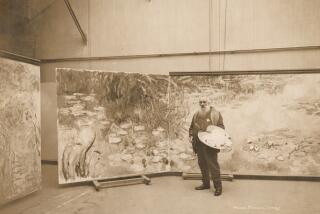Creative People: Their Inner Drive Awes Researchers
- Share via
BOSTON — Few achievements of human sweat are so difficult or so satisfying as creating something new--an insight, a melody, a turn of phrase that has never occurred to another soul in the history of the planet.
Psychologists poke into those moments of clear vision, so elusive and unpredictable, when fresh ideas are born, and they analyze the people who are blessed with a talent for bringing them to life.
Their goal is to learn what nourishes creativity, what kills it, what makes these masters of originality so different from the hordes who never rise above the commonplace.
The innovators of great and memorable works are in some ways surprisingly ordinary, it turns out. Studies show that they are frequently smart but not too brainy, educated but not too learned.
If anything sets them apart, it is their drive. They start young; they work hard; they keep going, often far into old age. Above all, they are motivated, and their drive to achieve comes from within.
Creativity is often a fragile thing, easily stifled. Researchers are learning that the forces that inspire it--or try to--also shape its quality.
At Brandeis University, psychologist Teresa M. Amabile has boiled down nine years of study into one observation: “Intrinsic motivation is conducive to creativity, but extrinsic motivation is detrimental.”
When people are inspired by their own interests and enjoyment, she said, there is a better chance that they will explore unlikely paths, take risks and, in the end, produce something unique and useful. When their goals are imposed on them by others, when they are goaded by fear of firing or lust for money, creativity withers.
Many endeavors--science, technology, the arts--live and die on people’s creativity. Yet those worlds are often filled with traps that kill the very originality that they need.
“I have found that there are a lot of social factors that undermine creativity,” Amabile said. “I suspect it may be easier to destroy creativity by adding things into the social environment than it is to stimulate creativity. It may be that the best environments are those that just allow creativity to be maintained without destroying it.”
The single best prod to creativity, she said, is freedom--the power to decide what to do and how to do it, a sense of control over one’s own ideas and work.
People who have successfully nourished the work of gifted people know freedom’s importance. Dr. Salvador E. Luria of Massachusetts Institute of Technology, mentor to several famous scientists and himself a Nobel laureate, contends: “The most important thing is to leave a good person alone.”
Like Artist Colony
Adds Dr. Mahlon B. Hoagland, scientific director of the Worcester Foundation for Experimental Biology: “I’ve often said that running a scientific institution is a lot like running an artist colony. The best an administrator can do is leave people alone to do what they want to do.”
Among the things that smother creativity, Amabile found, are frequent evaluation and criticism. A study of scientists and engineers in commercial laboratories showed that people flourish best when their output is not reviewed frequently.
“There’s a sense that they are professionals, and over time they are going to produce something that’s reasonable,” she said. “The people who are most inhibited in creativity are those who are in high-pressure environments where they have weekly or monthly performance appraisals.”
Offering rewards for coming up with innovative work also undermines originality, she said. Creative people need to feel that they are well paid and appreciated. But their work will suffer if the goal of each project is a bonus, not simply the pleasure of doing something well.
“They have to feel that as long as they put out good effort and in the long run come up with some good work, then they should have the freedom to take risks and to fail,” she said.
Amabile reached her conclusions mainly by conducting brief experiments in which volunteers worked out puzzles, wrote poems or performed other creative tasks while hindered or helped by such influences as rewards or surveillance.
Meanwhile, psychologist Dean Keith Simonton of the University of California, Davis, stalks clues to this perishable quality in the lives of highly creative people from times past. He recently summarized his work and that of other investigators in a book called “Genius, Creativity and Leadership.”
All Work Hard
One of the most striking findings that runs through the research is how hard these creative giants work.
“Genius is 1% inspiration and 99% perspiration,” goes Thomas Alva Edison’s famous line. And it seems to be true.
Edison held 1,093 patents. Albert Einstein wrote 248 publications. Pablo Picasso averaged over 200 works of art a year. Wolfgang Amadeus Mozart had more than 600 compositions to his credit before he died at age 35.
“For the most part, they tend to start earlier and end later,” Simonton said. “The idea of early burnout--that if you start early, you end early--is not true.”
U.S. Nobel laureates in science during this century averaged more than a dozen publications before their 30th year, about four times as many as ordinary scientists contribute over their entire lives.
Sigmund Freud wrote his first professional paper at 21. Johann Sebastian Bach dictated his last composition, well over his 1,000th, on his deathbed at age 65.
“Something appears to drive these creators to venture into the world of truth or beauty at an early age, to contribute masterworks at a hectic pace and to continue their creative endeavors until late in life,” Simonton said.
While good works may start early and end late, the peak productive age comes midway through the modern life span, or around age 40. Michelangelo finished the Sistine Chapel when he was 37, the same age that Ludwig van Beethoven wrote his Fifth Symphony.
Simonton studied 420 literary creators from 25 centuries of world literature. He found that the peak age for writing prose was about 43, while the peak for poetry fell around 39.
Yet the creative juices never totally dry up. In fact, he theorizes that creators in their 70s will be more prolific than they were in their 20s.
For all their prowess, however, awesomely inventive people are in some ways quite ordinary. Many were lackluster pupils, neither especially well educated nor particularly brainy.
Creative people are intelligent, but a high IQ is no guarantee of success. In fact, Simonton says there is evidence that too much brainpower may actually be a bad thing.
His studies suggest that the optimal IQ for creativity is about 19 points above the average of other people in the field. “In an area like physics,” he said, “where the average IQ is very high, say around 130, the best IQ would be about 149.”
Too much education also seems to get in the way of creativity. Of course, a revolutionary nuclear physicist may need a graduate degree just to understand the key problems of the field. But, in general, Simonton calculates that most famous scientists, philosophers, writers, artists and composers tend to complete their junior but not their senior year of college.
It may be, he said, that the most confident creative geniuses go to school until they obtain the basic knowledge and technical ability they need, then quit.
Amabile argues that there is nothing wrong with knowledge itself. The danger in education comes from picking up rote methods for doing things, little step-by-step procedures that blind people to offbeat but creative solutions.
“If you learn about a domain in ways that maintain flexibility in your thinking, if you learn basic principles rather than just rules, then knowledge can really help,” she said.
If creativity is not learned in a classroom, it at least appears to rub off when creative geniuses mingle with lesser beings. One study found that more than half of the Nobel laureates in science were apprentices of former Nobel winners.
Creativity also sometimes runs in families. There were at least 57 noteworthy Bachs in the German music world. Genes may play a role, but Simonton suggests that the elders of these families simply act as worthy role models for their offspring.
How much do the experiences of history’s titans apply to the creative stirrings of ordinary folk?
“It’s a difference of degree,” Simonton said. “A lot of this, such as the relationship between age and creativity and the importance of models, seems to be just as important on the more mundane level as it is on the Olympic level.”
Understanding what molds and motivates a creative genius is important, he said, for it could help people with less flashy gifts to resist the forces that choke their originality.
“There are pressures in our society to conform, to go along,” he said. “Einstein said what a genius needs most is just freedom to pursue. Generally our system is designed to be adverse to that.”
More to Read
Sign up for Essential California
The most important California stories and recommendations in your inbox every morning.
You may occasionally receive promotional content from the Los Angeles Times.













